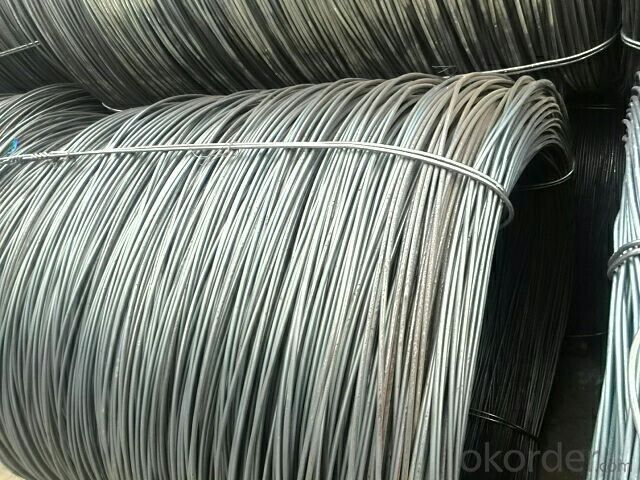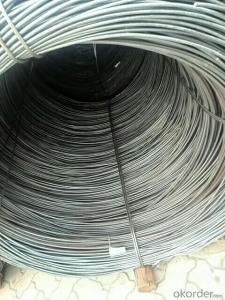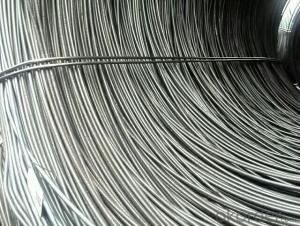Sae1008B AND Sae1006B High quality Wire Rod
- Loading Port:
- Tianjin
- Payment Terms:
- TT OR LC
- Min Order Qty:
- 100 m.t
- Supply Capability:
- 20000 m.t/month
OKorder Service Pledge
OKorder Financial Service
You Might Also Like
Product Description:
OKorder is offering Sae1008B AND Sae1006B High quality Wire Rod at great prices with worldwide shipping. Our supplier is a world-class manufacturer of steel, with our products utilized the world over. OKorder annually supplies products to European, North American and Asian markets. We provide quotations within 24 hours of receiving an inquiry and guarantee competitive prices.
Product Applications:
Sae1006B AND Sae1008B High quality Wire Rod are ideal for structural applications and are widely used in the construction of buildings and bridges, and the manufacturing, petrochemical, and transportation industries.
Product Advantages:
OKorder's Sae1008B AND Sae1006B High quality Wire Rodare durable, strong, and resist corrosion.
Main Product Features:
· Premium quality
· Prompt delivery & seaworthy packing (30 days after receiving deposit)
· Corrosion resistance
· Can be recycled and reused
· Mill test certification
· Professional Service
· Competitive pricing
Product Description:
Specifications of Sae1006B AND Sae1008B High quality Wire Rod :
Steel Grade: sae1006+sae1008B , Standard: GB Diameter: 5.5mm, 6.5mm, 7mm,8mm,9mm,10mm,12mm,14mm
Diameter Tolerance:±0.3mm 6.5mm can be drawing into 2mm/8.0mm can be drawing into 3mm
Brand Name: N-RIVER Place of Origin: Hebei, China Mainland Application: construction, building etc
Chemical Composition:
Please kindly find our chemistry of our material based on Q235 as below for your information
Trademark | Rank | Chemical composition (quality score) % | ||||||
C | Si | Mn | S | P | ||||
| ≤ |
| ≤ | ≤ | ||||
Q235 | A | 0.14-0.22 | 0.30 | 0.30-0.65 | 0.050 | 0.045 | ||
Q235 | B | 0.12-0.20 | 0.30 | 0.30-0.70 | 0.045 | 0.045 | ||
Trademark | Rank | Pulling Test | ||||||
Bend PointΔs/Mpa | Tensile Strength | Elongation Ratioδ5% | ||||||
Thickness (Diameter) /MM | Thickness (Diameter) /MM | |||||||
≤16 | 16-40 | ≤16 | 16-40 | |||||
≥ | ≥ | |||||||
Q235 | A | 235 | 225 | 375-500 | 26 | 25 | ||
Q235 | B | 235 | 225 | 375-500 | 26 | 25 | ||
Usage and Applications of Sae1008B AND Sae1006B High quality Wire Rod :
After hot-rolled the products shaped into coil and delivery as finished product, including round, square, rectangular, hexagonal and so on. Since most of the products are round, it is generally called wire rod. Carbon steel wire rod is widely used in construction and manufacturing. Carbon steel wire rod is mainly used for reinforcement of reinforced concrete and welded structure or reprocessed (roberts , nail, etc.) materials, especially used to produce wire drawing, welding electrode, nails, spring, electronic, precise machinery parts and so on.
Packaging & Delivery of Wire Rod Sae1006B AND Sae1008B :
Packaging Detail: products are packed in coil and then shipped by container or bulk vessel
Each coil weight: 2-3MT
Delivery Detail: within 45 days after received deposit or LC.
Label: to be specified by customer, generally, each bundle has 1-2 labels
Trade terms: FOB, CFR, CIF
FAQ:
Q1: Why buy Materials & Equipment from OKorder.com?
A1: All products offered byOKorder.com are carefully selected from China's most reliable manufacturing enterprises. Through its ISO certifications, OKorder.com adheres to the highest standards and a commitment to supply chain safety and customer satisfaction.
Q2: Can stainless steel rust?
A2: Stainless does not "rust" as you think of regular steel rusting with a red oxide on the surface that flakes off. If you see red rust it is probably due to some iron particles that have contaminated the surface of the stainless steel and it is these iron particles that are rusting. Look at the source of the rusting and see if you can remove it from the surface.
Q3: What is the normal tolerance of Hot Rolled Mild Steel Angle Beams for Structures and for Buildings?
A3: Normally 3%-5%, but we can also produce the goods according to the customers' requests.
Images:


- Q:How is steel wire rod used in the production of wire for suspension bridge cables?
- Steel wire rod is a crucial raw material used in the production of wire for suspension bridge cables. It is first processed at a steel mill, where it is heated and rolled into long, continuous wire rods. These wire rods are then further processed and drawn through a series of dies to reduce their diameter while increasing their strength. By subjecting the wire rod to this drawing process, the steel becomes more flexible and able to withstand the tension and pressure experienced by suspension bridge cables. The resulting wire is then twisted or braided together to form the final cable, which is used to support and suspend the bridge structure, ensuring its stability and durability.
- Q:What are the different tolerances for steel wire rods?
- The tolerances for steel wire rods can vary depending on the specific application and industry standards. However, there are generally accepted tolerance ranges for various dimensions of steel wire rods. One common tolerance is for the diameter or thickness of the wire rod. This can range from a few millimeters to several inches, depending on the intended use. For example, in the construction industry, wire rods used for reinforcing concrete may have a tolerance of +/- 0.5 mm, while wire rods used for manufacturing automotive components may have a tighter tolerance of +/- 0.1 mm. Another important tolerance to consider is the straightness of the wire rod. This refers to how straight the rod is along its entire length. Straightness tolerances can range from a few millimeters to a few centimeters per meter. For applications that require precise alignment, such as in the production of precision instruments or machinery, tighter straightness tolerances are necessary. Surface finish is another factor that can have specific tolerances for steel wire rods. This refers to the condition of the surface, including any imperfections or irregularities. Depending on the intended use, surface finish tolerances can range from as rough as a few micrometers to as smooth as a mirror-like finish. It's important to note that these tolerance ranges may vary slightly depending on the specific standards set by different organizations or countries. For instance, the American Society for Testing and Materials (ASTM) has its own set of tolerances for steel wire rods, while the International Organization for Standardization (ISO) has its own standards as well. In conclusion, the tolerances for steel wire rods can vary depending on factors such as diameter, straightness, and surface finish. These tolerances are essential to ensure that the wire rods meet the required specifications and can perform effectively in their intended applications.
- Q:How is steel wire rod used in the manufacturing of wire for automotive fuel injection systems?
- Steel wire rod is an essential component in the manufacturing of wire for automotive fuel injection systems. This high-quality steel wire is used to create the various wires and cables required for these systems. One of the primary uses of steel wire rod in the manufacturing process is for the production of fuel injector wiring harnesses. These harnesses are responsible for connecting the fuel injectors to the vehicle's electronic control unit (ECU). The steel wire rod is drawn into thin and precise wires that are then braided or twisted together to form the necessary harnesses. The steel wire rod used in this process is chosen for its exceptional strength, durability, and electrical conductivity. It must be able to withstand the harsh conditions under the hood of a vehicle, including high temperatures, vibrations, and exposure to chemicals. Additionally, steel wire rod is also used in the manufacturing of other wires and cables within the fuel injection system. These include sensor cables, which transmit data from various sensors to the ECU, and power cables, which provide electrical power to the fuel injectors. Overall, steel wire rod plays a crucial role in the manufacturing of wire for automotive fuel injection systems. Its strength, durability, and electrical conductivity ensure the proper functioning and longevity of these systems, ultimately contributing to the performance and efficiency of the vehicle.
- Q:Can steel wire rod be used for reinforcement purposes?
- Yes, steel wire rod can be used for reinforcement purposes. Steel wire rod is often used to reinforce concrete structures such as buildings, bridges, and highways. This is because steel has high tensile strength and can withstand heavy loads and stresses. When embedded in concrete, the steel wire rod helps to increase the overall strength and durability of the structure. It also helps to prevent cracking and improve the structural integrity. Steel wire rod is commonly used in the construction industry for reinforcement purposes due to its excellent mechanical properties and ability to enhance the performance of concrete structures.
- Q:What is a cold drawn steel wire? What does it usually do?
- Cold drawn low carbon steel wire used for prestressed concrete structures, such as beam, hollow floor, small poles, and rural construction of the purlin and door and window frames etc..
- Q:How is steel wire rod used in the production of wire ropes for mining applications?
- Steel wire rod is an essential component in the production of wire ropes for mining applications. Wire ropes used in mining are subjected to extreme conditions such as heavy loads, high tension, and harsh environments. Steel wire rods provide the necessary strength and durability to withstand these demanding conditions. Firstly, steel wire rod serves as the raw material for manufacturing wire ropes. The rod is generally made from high-quality carbon or alloy steel, ensuring the necessary strength and resilience required for mining operations. The rod is then processed through various stages such as hot rolling, cold drawing, and heat treatment to achieve the desired mechanical properties. Once the steel wire rod is processed, it is transformed into wire strands, which are then twisted together to form wire ropes. The strands are carefully constructed to withstand the high tension and heavy loads typically encountered in mining applications. The number of strands and the arrangement of wires within each strand are carefully selected to meet the specific requirements of the mining operation, taking into consideration factors such as load capacity, flexibility, and resistance to fatigue. Furthermore, steel wire rod contributes to the corrosion resistance of wire ropes used in mining. Mining environments often expose equipment to corrosive elements such as water, chemicals, and abrasive materials. Steel wire rods are typically coated or galvanized to provide a protective layer against corrosion, ensuring the longevity and reliability of the wire ropes even in harsh conditions. In mining applications, wire ropes are predominantly used for hoisting, hauling, and lifting heavy loads, such as mining equipment, ore, and personnel. The strength and flexibility provided by steel wire rods allow wire ropes to securely transport these loads over long distances and rough terrains. Additionally, wire ropes are crucial for ensuring the safety of personnel working in mines, as they are used for suspending platforms, securing mine shafts, and facilitating emergency rescues. In conclusion, steel wire rod plays a vital role in the production of wire ropes for mining applications. Its strength, durability, and corrosion resistance make it an ideal material for withstanding the extreme conditions encountered in mining operations. Wire ropes manufactured from steel wire rods provide the necessary load capacity, flexibility, and safety required for efficient and reliable mining operations.
- Q:How is steel wire rod used in the manufacturing of wire for electrical circuitry?
- Steel wire rod is a vital component in the manufacturing process of wire for electrical circuitry. It serves as the raw material that undergoes various treatments and processes to ultimately become the wire used in electrical circuits. The first step in utilizing steel wire rod is to subject it to a series of mechanical and chemical treatments. This includes processes such as heating, cooling, and drawing, which are aimed at enhancing its strength, flexibility, and conductivity. These treatments ensure that the wire will be able to withstand the electrical current flowing through it without breaking or losing its shape. Once the steel wire rod has been properly treated, it is then shaped into the desired form. This can involve further drawing, twisting, or braiding to achieve the necessary dimensions and characteristics required for electrical circuitry. The wire is often sized to specific diameters and coated with insulating materials, such as enamel or plastic, to prevent short circuits and protect it from external influences. The manufactured wire is then used in various applications within electrical circuitry. It can be employed in the production of electrical cables, where it serves as the conductor that carries the electrical current from one point to another. Additionally, the wire is also used in the construction of transformers, motors, generators, and other electrical equipment. The use of steel wire rod in the manufacturing of wire for electrical circuitry is crucial due to its excellent conductivity, strength, and durability. It ensures the safe and efficient transmission of electricity, while also withstanding the mechanical stress and environmental conditions it may encounter during its use.
- Q:How is steel wire rod used in the production of wire harnesses?
- Steel wire rod is a crucial component in the production of wire harnesses as it is used to create the core structure of the harness. The wire rod is first shaped into the desired diameter and then further processed to remove any impurities and improve its strength and flexibility. This processed wire rod is then coated with various materials to enhance its durability and electrical conductivity. Once completed, the wire rod is used as the foundation for the formation of the wire harness, providing the necessary support and connectivity for the electrical components within the harness.
- Q:How is steel wire rod tested for internal defects?
- Steel wire rod is tested for internal defects using non-destructive testing methods such as ultrasonic testing or electromagnetic testing. These techniques involve passing high-frequency waves or electromagnetic fields through the rod to identify any internal flaws or defects. By analyzing the reflected waves or electromagnetic signals, any hidden defects such as cracks, voids, or inclusions can be detected, enabling manufacturers to ensure the quality and integrity of the steel wire rod.
- Q:What are the different types of steel wire rod coatings used for enhanced wear resistance?
- There are several types of steel wire rod coatings used for enhanced wear resistance, including zinc coatings, galvanized coatings, and polymer coatings. Zinc coatings provide a protective barrier against corrosion and can increase the durability of the wire rod. Galvanized coatings involve the application of a layer of zinc through a hot-dip process, offering excellent corrosion resistance and improved wear resistance. Polymer coatings, on the other hand, utilize a layer of synthetic material to provide enhanced wear resistance and decreased friction. These coatings are applied to steel wire rods to extend their lifespan and improve their performance in various applications.
1. Manufacturer Overview |
|
|---|---|
| Location | |
| Year Established | |
| Annual Output Value | |
| Main Markets | |
| Company Certifications | |
2. Manufacturer Certificates |
|
|---|---|
| a) Certification Name | |
| Range | |
| Reference | |
| Validity Period | |
3. Manufacturer Capability |
|
|---|---|
| a)Trade Capacity | |
| Nearest Port | |
| Export Percentage | |
| No.of Employees in Trade Department | |
| Language Spoken: | |
| b)Factory Information | |
| Factory Size: | |
| No. of Production Lines | |
| Contract Manufacturing | |
| Product Price Range | |
Send your message to us
Sae1008B AND Sae1006B High quality Wire Rod
- Loading Port:
- Tianjin
- Payment Terms:
- TT OR LC
- Min Order Qty:
- 100 m.t
- Supply Capability:
- 20000 m.t/month
OKorder Service Pledge
OKorder Financial Service
Similar products
New products
Hot products
Hot Searches
Related keywords




























